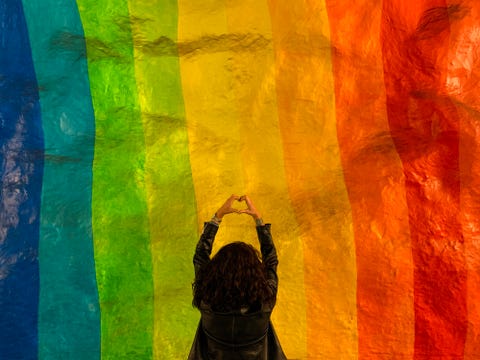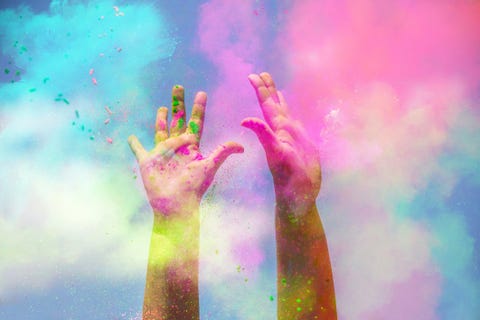What Is the Color for Mental Health
We are visual creatures. As we navigate the world, light comes in through our eyes and is translated into signals in our brains that help us determine whether we should approach or move away — whether what we see is welcoming and friendly or threatening and something to be avoided. Color plays a tremendous role in how we react and respond to things around us. It can affect the way we feel, how we think, how we interact with one another, and whether or not we buy a specific item. Color is a subtle yet powerful communication tool, and it informs the way we see and how we feel about the world.
The study of color and its impact on how we think and feel falls into an area of psychology called environmental psychology. Essentially, this is the study of how the physical world around us impacts our brains. Sally Augustin, Ph.D., is the principal at Design with Science, a consulting firm based in Illinois, that helps businesses and individuals choose the right textures, colors, lighting, and ambiance for their physical spaces. She says that the scientific study of how colors, textures, and the sense of space impact our moods, thoughts, and productivity have been around since the 1960s. But, she says that the way that color affects us dates back to the early days of humankind.

Getty Images
"One thing to remember," Augustin cautions. "is that color isn't magic. People are puzzles, and each person is taking it all in through their own sensory apparatus, their own cultural perspective, and their own experience. You can have someone paint all the walls in their house yellow and immediately think that they will be happy and successful. You can put me in a room that might be the perfect color for creative thinking and ask me to think creatively about physics, but, since I am not an expert at physics. Nothing is going to happen."
That being said, major corporations and retail businesses continually use color, texture, lighting, and ambiance to influence our purchasing decisions. It impacts everything from the color of the frozen food section at the grocery store (consider what it would be like if it was red instead!) to the color of the cars we drive. In fact, the automobile company Jaguar dedicates a relatively large team to determine the materials and colors that they use in upcoming vehicles specifically because they want buyers to have a particular experience of owning and driving a Jaguar. Siobhan Hughes is the Chief Designer for Jaguar's color and materials, and she says that color and texture play a major role in Jaguar's branding and future planning.
"There is a team of experts dedicated to this aspect of design, working in conjunction with the interior and exterior designers," Hughes says via email. " It can take up to four years to develop a new interior and exterior color or material. Therefore it is our job to predict the colors that will still be relevant four years hence. Key trends and aesthetics steer our investigations to create interesting, innovative, and culturally relevant concepts that align to the Jaguar brand values."
Environmental psychology is the science of how what's in the world around you influences what goes on in your head. We think about things like how surface colors or colors of light influence how you think and behave.
While many studies show how color and texture can influence human behavior, there's no evidence that using colored lights or surrounding yourself in a specific color actually improves real medical ailments. There's a rising trend of "color therapy," or chromotherapy touting "amazing" benefits and miraculous healing or improvement in mental health, yet there is a lot of controversy around those claims. To date, there isn't much science to back them up.
That being said, when it comes to color theories and new-age practices, you'll probably hear about healing your chakras in yoga class, or how a specific color can invite luck in Feng Shui. Many cite a 2005 text called The Scientific Basis of Integrative Medicine, which ventured into the area of what's known as subtle energy medicine and tried to prove a stronger scientific connection between many things, including the influence of color on physical health and mental well-being. While the science is not quite there, there is some veracity to the idea that those who strongly believe in the healing power of chakras, Feng Shui and even color therapy, in the same way, that those who deeply believe in a specific religion, benefit from their practices and rituals around the central tenants of color.
The basics of color
The "healing" powers of color have been touted for hundreds of years. Even well-known philosophers like Goethe wrote about the power of color.
As Augustin points out, there are three basic elements to color: hue, saturation, and brightness. Hue refers to the names we give to wavelengths of color. So "orange" or "red" is the specific hue. Saturation is what Augustin says is how "pure" the colors are. "Colors that are less pure are more greyish," she says. Brightness refers to how much white is in the color.
"Saturation and brightness inform our response to colors," Augustin says. "So if you want to create a space for relaxation, walls, or surfaces that are not very saturated but are relatively bright, lighter colors are ideal. Say you get a bucket of paint in sage green and then imagine dumping a whole bucket of white paint into it. That's a great color for a space for people to feel more relaxed."
Augustin points out that color impacts the way we feel about a space, but it doesn't mean that we won't have a negative reaction if we experience something negative in that space.
"I can tell you about calming colors, but if you give people bad news in a room with those common colors on the walls, it doesn't mean that they will be calmer," Augustin says.
How you can apply color to improve or enhance your life
Whether you buy into the idea of color therapy or the associated beliefs around the healing benefits of color, there are proven ways to use color to enhance and improve your life. The first step, however, is to do some research. Augustin suggests that before committing to painting your laundry room sapphire blue to help you get through it faster, you do some digging on what the real science says.

Artur Debat Getty Images
"Look for studies published in peer-reviewed journals and look at the credentials of those publishing," she says. "If you are making a big investment in changing your home or your office, it's worth the time to be sure you have researched the science behind it."
While specific colors have been proven to do things like enhance concentration and increase perceived relaxation, it's important to take your own psychology, culture, and history into consideration. Different people respond differently to a variety of colors. For example, in western culture, the color white is associated with purity, cleanliness, and innocence, yet in many other cultures around the world (eastern in particular), white is associated with death and mourning.
Red and Orange
Red and orange are warm colors that, Augustin says, increases the sensation of heat and warmth. If you paint a dim, cool room with a color in the spectrum of red and orange, Augustin says, you'll perceive the room as warmer. Red walls or clothing draw our attention and can be a sign of warning. Red can also be associated with aggression, as well as stimulation and passion. Orange and red are also associated with hunger and food, though some studies have shown that people eat less when food is put on a red plate.
Yellow
Considered to be the color of joy, yellow is also a warm color making it welcoming and engaging. If you live in an area that tends to be gloomy and cool, yellow can help make it seem warmer and more cheerful. Yellow has also been associated with mood-boosting and positive thinking.
Green
Green is easy on the eyes, literally. We have three types of color receptors in our eyes, called cone cells. These cone cells see red, green, and blue easily, and green, since it falls in the middle of the spectrum of light we see, is easy for us to perceive (unless you are colorblind, of course). Green is associated with calming properties, which is why many schools, hospitals, and medical buildings are green inside.
Blue
Blue is considered to be an energizing color, and in some shades can be calming. Blue is also associated with concentration and clarity of thought, according to studies.
Violet
Purple or violet is a combination of the two extremes of the visible color we see: red, which is the hottest color, and blue, which is the coolest. Purple has similar soothing properties to blue and can be an imagination stimulator as well.

oxygen Getty Images
Black
As mentioned above, in western culture, black is associated with death, mourning, and sorrow, but it can also be associated with power and rebirth. A black room can make things feel a bit melancholy or elicit feelings of intimacy, closeness, and drama.
White
White is ubiquitous as a room color and often used to make space feel larger, cleaner, and more open. White rooms are often seen as blank canvases for a variety of pursuits.
It's essential to consider the color and space, Augustin points out, before committing to a color. You may not want to paint a bedroom purple (imagination is excellent, nightmares are not), or red (passion is great, but the color can cause some people to feel more awake), but those colors could be perfect for a home office or a kitchen. It all depends on what you are trying to achieve and how you specifically feel about the colors. The brightness of the color also matters.
"For most of us, you want to use light colors on the walls because they make a space seem bigger than it is. Most of us live in spaces where we wish everything was just a little bit bigger, but if you are trying to create the smaller cozy effect, use a darker color. That creates the impression of the walls being closer," she says.
"Environmental psychology is the science of how what's in the world around you influences what goes on in your head," Augustin continues. "We think about things like how surface colors or colors of light influence how you think and behave, why what you feel underfoot matters, how high the ceiling is, or the walls seem to be, how that all comes into play. Because life is always more complex, it's important to factor in issues like how people's personalities or national culture come into play, too."
Abigail Bassett is an Emmy-winning journalist, writer and producer who covers wellness, tech, business, cars, travel, art and food. Abigail spent more than 10 years as a senior producer at CNN. She's currently a freelance writer and yoga teacher in Los Angeles. You can find her on Twitter at @abigailbassett.
Get Shondaland directly in your inbox: SUBSCRIBE TODAY
This content is created and maintained by a third party, and imported onto this page to help users provide their email addresses. You may be able to find more information about this and similar content at piano.io
What Is the Color for Mental Health
Source: https://www.shondaland.com/live/body/a33463636/the-impact-of-color-on-our-well-being/